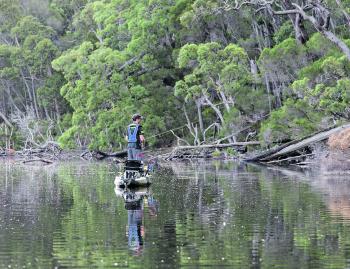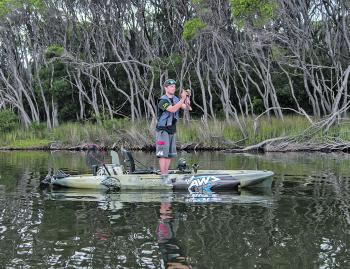Several years ago, while holidaying in Mallacoota, I was faced with a dilemma. Our trip coincided with the week leading up to a Hobie Kayak BREAM Series event, which I was competing in and with the pre fish ban in full swing, I was unable to fish the inlet.
After scanning Google Maps in an effort to scope out potential hotspots nearby, I noticed a small system only a short drive to the south of Mallacoota: the Betka River. The decision was made to hit the water at first light and scope it out. The session turned out to be a cracker, with plenty of species landed. I had discovered a new spot and now I rarely travel to Mallacoota without paying the Betka a visit.
Nestled among thick native forest, the river meanders its way through the Croajingolong National Park before entering the waters of Bass Strait just over 3km south west of Mallacoota. The banks are lined with a plethora of tall native gums, many of which have fallen into the river over the years, creating banks with laydown timber; perfect fish-holding structure.
The Betka River has no boat ramp and as a result it is very difficult to get a boat on the water, however there are a number of small gravel tracks leading down to the water that are perfect place to launch your kayak from the bank. Most of these roads are unnamed, making it difficult to provide directions. A quick search on Google Maps of the area off Betka Road will easily identify these launch sites. I almost always launch from a small track leading off Betka Road opposite the Betka River Tourist Reserve. There is a small clearing at the end of the track suitable to park a few cars with direct access to the water.
As is typical with most estuaries along the Victorian coastline, bream are plentiful in the Betka and can be caught throughout the system all year round. However, with bigger and better bream on offer in the nearby Mallacoota inlet, it’s the estuary perch that live deep in amongst the fallen timber of the Betka that keep me coming back for more. Dusky flathead are also present in the system and can grow surprisingly large, despite it being a relatively small system.
Casting hardbodied lures in tight amongst the fallen timber snags that litter the system is an absolute highlight of any trip to the Betka, and often results in some truly explosive fishing. Topwater lures are exceptionally productive, and due to the nature of the snaggy terrain along the banks of the Betka, they are often your only option when targeting bream and perch holding deep within the snags. OSP Bent minnows cast in as deep as you dare and retrieved using an erratic twitch and pause retrieve can be dynamite on both perch and bream.
Kayaks are perfectly suited to this type of fishing. Their near to silent movement through the water gives the kayak angler a distinct advantage when fishing snags, meaning the angler can get a lot closer to their chosen target snag without spooking fish. The cast is essential, and landing the lure as close as possible to the most likely looking spot will dramatically increase your bites. Often, casting over the top of branches into small pockets of water surrounded by timber is the best way of convincing a solid perch or bream to commit to your offering. This technique, however, has its challenges and often you can spend more time retrieving snagged lures than actually fishing, but once that solid fish is safely within the net this is all quickly forgotten.
Soft plastics are also a productive and cost-effective presentation at the Betka. Most anglers are far more willing to cast a plastic into heavy timber and they are certainly well worth a flick. Working unweighted, weedless grubs or creature baits cast amongst the snags is another favoured technique of mine when fishing the Betka. Allowing the plastic to naturally fall into the structure before slowly retrieving with a series of small hops and pauses can be dynamite. The same plastics rigged on a jighead and allowed to sink down adjacent to the snags is also worth a shot.
The road bridge and flats towards the front of the system are always worth a look too. The bridge will often hold good schools of bait and as a result the bream won’t be far away. Casting crab imitation hardbodies in close against the bridge pylons can be very effective. Working plastics in the same area is always worth a go too. Equally, the flats down the front are another excellent place to target bream in particular. Casting shallow diving hardbodied lures and working them with a twitch and pause retrieve can often entice a bite, particularly when the prawns are present. Targeting fish on the drop-offs and around the edges of the flats is another productive technique. Deeper diving hardbodied lures or soft plastics rigged on a weighted jighead are my go-to when fishing the drop-offs.
The Betka River offers kayak anglers a protected waterway that can often be fished when conditions at the nearby Mallacoota Inlet are too messy to venture out. Mobile coverage can be patchy at best in the area, so make sure you inform someone of your plans when fishing the area. As always, remember to wear a PFD and keep a bailer onboard as required by Victorian state law.
The Betka River is a remarkable fishery. It receives very little pressure, with most anglers travelling to the area preferring to fish Mallacoota Inlet, however if a kayak is your chosen craft then the Betka certainly has plenty to offer. Next time you’re fishing ‘Coota, make sure you set aside some extra time to explore this untouched, pristine waterway and experience some truly exciting fishing.
Reads: 5463
Dale Baxter with an excellent example of a Betka River bream taken on a Daiwa Slippery Dog. Photo courtesy of Darren Weda.

Casting surface lures in tight amongst the fallen timber is a highlight of any trip to the Betka.

The banks of the Betka River are littered with fallen timber, perfect fish holding structure and home to many big bream and perch. Photo courtesy of Darren Weda.

Darren Weda prospecting some likely looking water during a recent afternoon session on the Betka.

The Betka River, a pristine waterway perfectly suited to kayak angling. Photo courtesy of Darren Weda.




